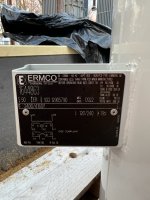hockeyadc
Member
- Location
- New Jersey
- Occupation
- EE
Is it possible to connect a distribution transformer with a primary rating of 2400/4160Y and 2 bushings to an ungrounded 4160 delta configuration? This is coming off of the tertiary of a transformer. My understanding is that this is a 2400 phase to ground rating, and would work at 4160 phase to phase with no ground? Or is that incorrect and we actually need a 4160/7200Y transformer to connect phase to phase to this ungrounded delta?

